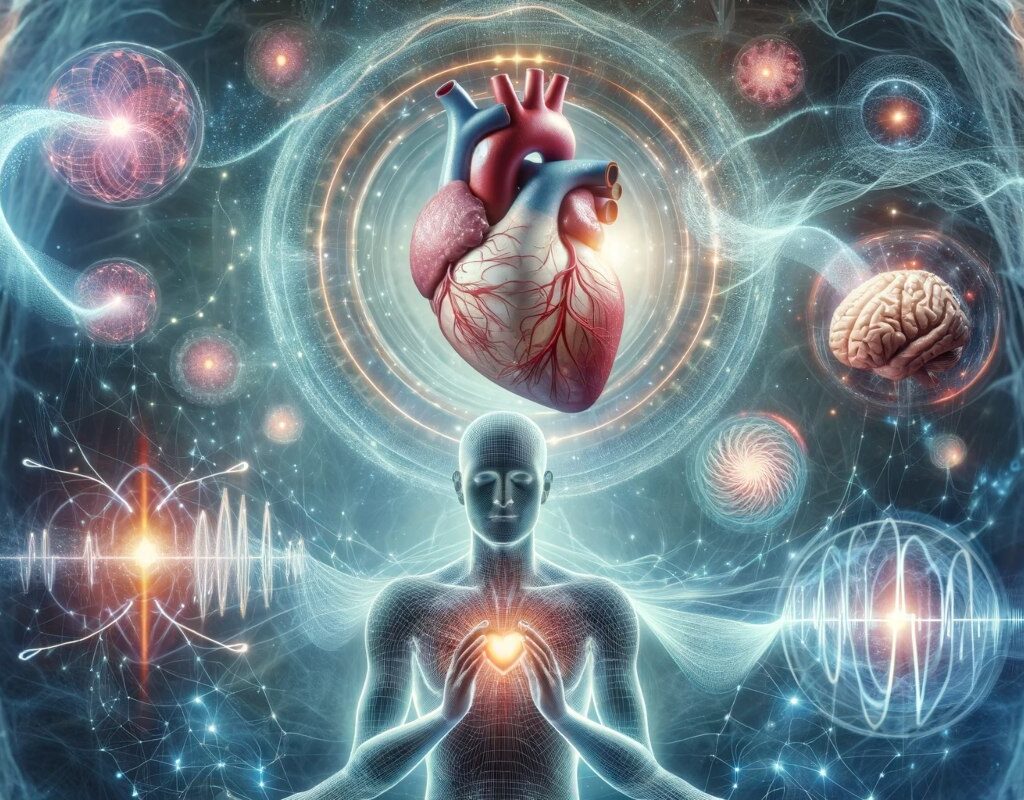Recent research challenges the notion that consciousness arises solely from the brain, suggesting a joint origin with the body. Specifically, the heart stands out in this process, not just as a pump but as a complex organ with its own “functional brain.” Neurocardiology reveals that the heart is an advanced sensory organ, capable of learning, remembering, and making decisions independent of the cerebral cortex.
The Intelligent Heart: More Than a Vital Organ
Neurocardiology: The Heart as a Center of Perception and Emotion
Moreover, it has been demonstrated that the heart significantly influences brain functions, including perception, cognition, and emotions.
This influence extends through a network of nervous communication and an electrical field. The heart generates the most potent electrical field in the body, far stronger than that of the brain, affecting every cell and detectable at a distance.
The heart emits electromagnetic pulses with variations in the time between beats, influencing bodily processes. Brain rhythm can synchronize with the heart’s rhythmic activity, especially during emotions such as love or appreciation, affecting blood pressure and breathing.
It’s proposed that the heart’s field functions as a wave of information, synchronizing the body. Waves emitted by the heart interact with other organs, encoding and distributing patterns of energy throughout the body, thus coordinating bodily functions.
The HeartMath Institute has researched how a person’s emotions alter the rhythmic patterns of the heartbeat, communicating emotional information through the heart’s electromagnetic field.
Heart Rhythms: The Mirror of Our Emotions
Cardiac Coherence: How Emotions Shape Our Psychophysiological Well-being
Negative feelings, like anger or frustration, generate irregular and disordered patterns in the heart rhythm, contrasting with the smooth and coherent patterns associated with positive emotions like love or appreciation.
These changes in heart rhythm alter the structure of the heart’s electromagnetic field, measurable through spectral analysis. A state of psychophysiological coherence during continuous positive emotions has been identified, where the heart rhythm shows sinusoidal wave patterns, and the electromagnetic field becomes organized.
Physiologically, this state is characterized by increased efficiency in the activities and interactions of bodily systems. Psychologically, it’s associated with reduced internal mental dialogue, lower perception of stress, better emotional balance, and enhanced mental clarity and cognition.
Research suggests that psychophysiological coherence is crucial for improving bodily sensory awareness and optimizing emotional stability, brain function, and actions. An increase in awareness and sensitivity towards others in this state has also been observed.
Experiments have demonstrated that the heart’s electromagnetic field can transmit information between people, even at a distance. A person’s brain waves can synchronize with another’s heart rhythm, especially when one of them is in a state of psychophysiological coherence.
These findings indicate that people in coherence are more receptive to information encoded in others, suggesting that the nervous system functions like an antenna responding to the electromagnetic fields of other hearts. This capacity for information exchange facilitates deeper non-verbal communication, understanding, and connection and may even extend to interactions between humans and animals.
Intuition and Connection: The Hidden Power of the Heart
Beyond Time and Space: The Heart’s Intuitive Perception
The heart’s field is closely linked with intuitive perception, connecting to an energy field that transcends space and time.
Evidence has been found suggesting that both the heart and brain can receive and respond to information about future events before they occur, with the heart being the first to receive this intuitive information. This implies that the heart’s field might be associated with a more subtle energy field containing information about distant or future events.
In social contexts, it is proposed that just as the heart generates energy in the body, the social collective regulates energy within the social system. Studies have shown that socio-emotional interaction between mother and child is crucial for brain development, consciousness, and healthy self-esteem. Positive emotions and highly synchronized reciprocal exchanges in these interactions significantly influence the child’s psychosocial function throughout life.
A longitudinal study of social groups documented how a group’s collective consciousness is transmitted to its members through a socio-emotional energy field. Coherent organization in a group’s social structure is associated with a network of positive emotions, creating an energy field that encodes and distributes information about the group’s social structure.
The correspondence between the information of the parts and the whole suggests a principle of holographic organization, where the complete group’s information is distributed through an energy field. This implies that both the heart field identified in HeartMath studies and the hypothetical social field are energy fields operating on holographic quantum principles, where each part of the field contains information about the total organization of the system.
Harmony of Heart and Society: Towards a Collective Consciousness
Breathing with Attitude: HeartMath’s Technique for Psychosocial Coherence
Positive emotions, such as love and appreciation, play a crucial role in generating coherence between the heart and social fields.
When energy is intentionally regulated to achieve coherent and harmonious order, the flow and integrity of information are enhanced, resulting in a functional and stable system that benefits health, psychosocial well-being, and relationships.
Cardiac and social coherence reinforce each other: as individuals within a group increase their psychophysiological coherence, so does the psychosocial harmony, thereby improving coherence in social relationships. Conversely, a coherent social field supports the generation and maintenance of psychophysiological coherence among its members.
This coherence leads to increased awareness and knowledge, affecting the body’s internal physiology, emotional and mental processes, and a deeper order within energy fields. This is fundamental for self-awareness, social sensitivity, creativity, intuition, spiritual vision, and understanding of ourselves and our environment.
The intentional generation of coherence in the heart and social fields can propel a move toward a higher level of planetary consciousness, in harmony with the movement of the whole.
The HeartMath Institute has developed a technique called “Breathing with Attitude,” synchronizing the heart, mind, and body to strengthen psychophysiological coherence. This technique involves focusing on the heart and solar plexus while breathing with a positive attitude. Regular practice promotes a lasting change in attitude and increases awareness and clarity.
The technique consists of inhaling through the heart and exhaling through the solar plexus, concentrating on positive attitudes to balance negative emotions. Although an immediate change may not be perceived, genuine effort leads to a more neutral and objective state, conserving energy.
The Technique of Breathing with Attitude
- Focus on your heart while inhaling. As you exhale, focus on the solar plexus. The solar plexus is located about 4 inches below the heart, just beneath the sternum where the right and left sides of the rib cage meet.
- Practice inhaling through the heart and exhaling through the rib cage for 30 seconds or more to help anchor your attention and energy there. Then choose a positive attitude or thought to inhale or exhale during those 30 seconds or more. For example, you might inhale an attitude of appreciation and exhale one of care.
- Select attitudes to breathe that help compensate for the negative emotions and imbalance of the situations you are going through. Breathe deeply to move towards the feeling of that attitude. For example, you might inhale an attitude of balance and exhale one of mercy, or you might exhale an attitude of love and exhale one of compassion.
Practice different combinations of attitudes you want to develop.
This exercise is part of the book “Transforming Stress: The HeartMath Solution for Relieving Worry, Fatigue, and Tension” by Rollin McCraty, Ph.D.




